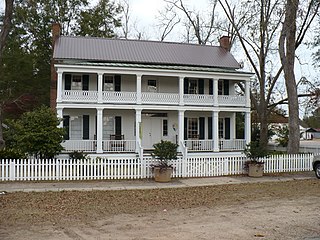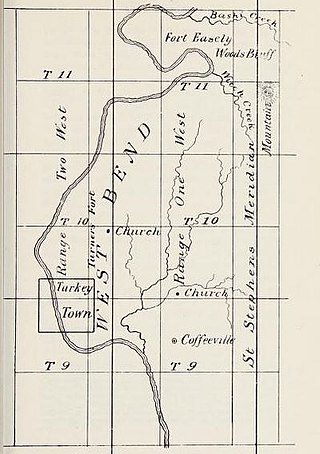
Clarke County is a county located in the southwestern part of the U.S. state of Alabama. As of the 2020 census, the population was 23,087. The county seat is Grove Hill. The county's largest city is Jackson. The county was created by the legislature of the Mississippi Territory in 1812. It is named in honor of General John Clarke of Georgia, who was later elected governor of that state.
Red Sticks —the name deriving from the red-painted war clubs of some Native American Creek—refers to an early 19th century traditionalist faction of Muscogee Creek people in the Southeastern United States. Made up mostly of Creek of the Upper Towns that supported traditional leadership and culture, as well as the preservation of communal land for cultivation and hunting, the Red Sticks arose at a time of increasing pressure on Creek territory by European American settlers. Creek of the Lower Towns were closer to the settlers, had more mixed-race families, and had already been forced to make land cessions to the Americans. In this context, the Red Sticks led a resistance movement against European American encroachment and assimilation, tensions that culminated in the outbreak of the Creek War in 1813. Initially a civil war among the Creek, the conflict drew in United States state forces while the nation was already engaged in the War of 1812 against the British.

The Fort Mims massacre took place on August 30, 1813, during the Creek War, when a force of Creek Indians belonging to the Red Sticks faction, under the command of head warriors Peter McQueen and William Weatherford, stormed the fort and defeated the militia garrison. Afterward, a massacre ensued and almost all of the remaining mixed Creek, white settlers, and militia at Fort Mims were killed. The fort was a stockade with a blockhouse surrounding the house and outbuildings of the settler Samuel Mims, located about 35 miles directly north of present-day Mobile, Alabama.

Samuel Dale, known as the "Daniel Boone of Alabama", was an American frontiersman, trader, miller, hunter, scout, courier, soldier, spy, army officer, and politician, who fought under General Andrew Jackson, in the Creek War, later, becoming a brigadier general in the U.S. Army, and an advocate for Alabama statehood.

The Alston–Cobb House, now formally known as the Clarke County Historical Museum, is a historic house and local history museum in Grove Hill, Alabama. It was built in 1854 by Dr. Lemuel Lovett Alston as a Greek Revival I-house, a vernacular style also known in the South as Plantation Plain. It is one of only four examples of an I-house to survive intact in Clarke County. The Alston–Cobb House was added to the Alabama Register of Landmarks and Heritage on September 1, 1978, and to the National Register of Historic Places on April 30, 1979.

Fort Sinquefield is the historic site of a wooden stockade fortification in Clarke County, Alabama, near the modern town of Grove Hill. It was built by early Clarke County pioneers as protection during the Creek War and was attacked in 1813 by Creek warriors.

Fort Strother was a stockade fort at Ten Islands in the Mississippi Territory, in what is today St. Clair County, Alabama. It was located on a bluff of the Coosa River, near the modern Neely Henry Dam in Ragland, Alabama. The fort was built by General Andrew Jackson and several thousand militiamen in November 1813, during the Creek War and was named for Captain John Strother, Jackson's chief cartographer.

Fort Claiborne was a stockade fort built in 1813 in present-day Monroe County, Alabama during the Creek War.
Ferdinand Leigh Claiborne was an American military officer most notable for his command of the militia of the Mississippi Territory during the Creek War and the War of 1812.

Fort Armstrong was a stockade fort built in present-day Cherokee County, Alabama during the Creek War. The fort was built to protect the surrounding area from attacks by Red Stick warriors but was also used as a staging area and supply depot in preparation for further military action against the Red Sticks.
Fort Carney was a stockade fort built in 1813 in present-day Clarke County, Alabama during the Creek War.

Chinnabee, also spelled Chinneby or Chinnibee, is an unincorporated community in Talladega County, Alabama, United States.

Fort Easley was a stockade fort built in 1813 in present-day Clarke County, Alabama during the Creek War.

Fort Glass was a stockade fort built in July 1813 in present-day Clarke County, Alabama during the Creek War.
Fort Landrum was a stockade fort built in 1813 in present-day Clarke County, Alabama during the Creek War. The fort was located eleven miles west of Fort Sinquefield. Fort Landrum, like many other forts built around the same time, was built in response to Red Stick attacks on settlers in the surrounding area.

Fort Leslie was a stockade fort built in present-day Talladega County, Alabama, in 1813 during the Creek War. After the Creek War began, protective stockades were built by settlers and Creeks who were allied with the United States to protect themselves from hostile Creek attacks. Fort Leslie was the focal point of the Battle of Talladega but was soon abandoned after the end of the Creek War.

Fort Madison was a stockade fort built in August 1813 in present-day Clarke County, Alabama, during the Creek War, which was part of the larger War of 1812. The fort was built by the United States military in response to attacks by Creek warriors on encroaching American settlers. The fort shared many similarities to surrounding stockade forts in its construction but possessed a number of differences in its defenses. The fort housed members of the United States Army and settlers from the surrounding area, and it was used as a staging area for raids on Creek forces and supply point on further military expeditions. Fort Madison was subsequently abandoned at the conclusion of the Creek War and only a historical marker exists at the site today.
Fort Montgomery was a stockade fort built in August 1814 in present-day Baldwin County, Alabama, during the Creek War, which was part of the larger War of 1812. The fort was built by the United States military in response to attacks by Creek warriors on encroaching American settlers and in preparation for further military action in the War of 1812. Fort Montgomery continued to be used for military purposes but in less than a decade was abandoned. Nothing exists at the site today.
Fort Pierce, was two separate stockade forts built in 1813 in present-day Baldwin County, Alabama, during the Creek War, which was part of the larger War of 1812. The fort was originally built by settlers in the Mississippi Territory to protect themselves from attacks by Creek warriors. A new fort of the same name was then built by the United States military in preparation for further action in the War of 1812, but the fort was essentially abandoned within a few years. Nothing exists at the site today.














